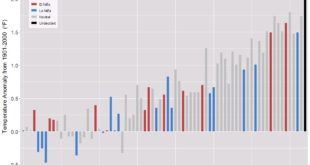This blog has alr eady noted a the feedback loop from melting permafrost, Methane Bubbles – A Feedback Loop. A recent BBC article, There Are Diseases Hidden In Ice And They Are Waking Up – Long-dormant bacteria and viruses, trapped in ice and permafrost for centuries, are reviving as Earth’s climate warms, is a well referenced article about the possible consequences of melting permafrost (picture from the article with caption: Bacteria have been found dormant in Antarctic ice (Credit: Colin Harris/Era Images/Alamy)).
eady noted a the feedback loop from melting permafrost, Methane Bubbles – A Feedback Loop. A recent BBC article, There Are Diseases Hidden In Ice And They Are Waking Up – Long-dormant bacteria and viruses, trapped in ice and permafrost for centuries, are reviving as Earth’s climate warms, is a well referenced article about the possible consequences of melting permafrost (picture from the article with caption: Bacteria have been found dormant in Antarctic ice (Credit: Colin Harris/Era Images/Alamy)).
“Permafrost is a very good preserver of microbes and viruses, because it is cold, there is no oxygen, and it is dark,” says evolutionary biologist Jean-Michel Claverie at Aix-Marseille University in France. “Pathogenic viruses that can infect humans or animals might be preserved in old permafrost layers, including some that have caused global epidemics in the past.”
If you are incorporating climate change issues in the classroom then the article provides for excellent classroom discussions with interesting science. The article concludes:
How much should we be concerned about all this?
One argument is that the risk from permafrost pathogens is inherently unknowable, so they should not overtly concern us. Instead, we should focus on more established threats from climate change. For instance, as Earth warms northern countries will become more susceptible to outbreaks of “southern” diseases like malaria, cholera and dengue fever, as these pathogens thrive at warmer temperatures.
The alternative perspective is that we should not ignore risks just because we cannot quantify them.
“Following our work and that of others, there is now a non-zero probability that pathogenic microbes could be revived, and infect us,” says Claverie. “How likely that is is not known, but it’s a possibility. It could be bacteria that are curable with antibiotics, or resistant bacteria, or a virus. If the pathogen hasn’t been in contact with humans for a long time, then our immune system would not be prepared. So yes, that could be dangerous.”
It would be nice if these articles discussed the populations most at risk. It is often the case that those of lower socioeconomic status are more vulnerable. Many issues related to climate change have both a social justice component, as well as an ethical question related to the fact that those that contribute little to climate change are often impacted disproportionately.
